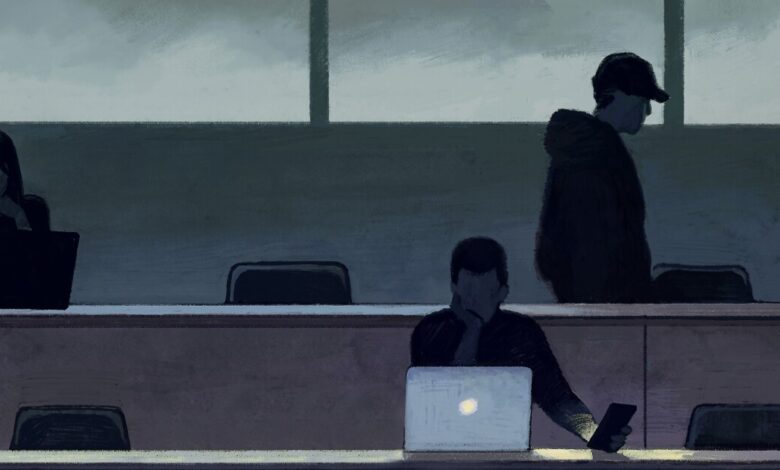Community-College Leaders Wrestle With an Uncertain Future

Community-college enrollment took a nosedive during the pandemic, and many institutions have since struggled to recover. At a recent gathering in New York, college leaders discussed a variety of strategies to recruit and retain more students, including ramping up sports programs, enhancing marketing material, providing more student support, and being more explicit with prospective students about how their college degrees can lead directly to a job.
“Community colleges were designed to be receivers of students; now it’s time for them to be recruiters of students,” Tom Green, director of strategic enrollment management for the technology company Salesforce, said during one panel discussion.
Even with the proper strategies, however, it’s not clear that the colleges can overcome the long-term economic and mental-health impacts of the pandemic, the overall decline in high-school graduates, and a growing skepticism about the value of postsecondary education.
The annual leadership conference of the Association of Community College Trustees, which met last week in New York City, was titled “Improving the Lives of Entire Families” to underscore the idea that open-access public colleges are vital educational and economic ladders for millions of students, particularly low-income, first-generation students, as well as for working adults.
A strong economy and other factors led to a slow decline in community-college enrollment since it peaked in the fall of 2011, according to data from the National Center for Education Statistics, presented by Green. Things got much worse during the pandemic, though it’s not entirely clear why, since community-college enrollment typically increases during economic downturns. Higher-education experts have theorized that a lack of access to the internet, the absence of child care for working adults, as well as the loss of service-sector jobs kept many students from pursuing college at the time.
The improving economy since then has compounded the enrollment challenges, as students opt for higher-paying jobs over the price of tuition. In the spring semester of 2022, community-college enrollment was nearly 8 percent less than in the spring of 2021. It had fallen 10 percent the year before.
When institutions ask how they can afford investments in student support, we ask, how can they not?
For some colleges, a combination of factors has decimated enrollment over the past decade. At North Shore Community College, in Massachusetts, the declining number of high-school graduates, the impact of the pandemic, and the more recent high demand for entry-level workers have led to a 50-percent decline in students over the past decade, said J.D. LaRock, chair of the college’s Board of Trustees.
“This is a reality we’ve been living with in New England for a while,” LaRock said.
Community colleges can no longer afford to be passive about enrollment management, said administrators and industry consultants who recommended a variety of ways to enhance student recruitment and retention.
Green, who is also a former enrollment-management administrator, recommended that colleges develop more-sophisticated marketing and communications plans to ensure students understand the opportunities at the institution. For instance, they might hire someone specifically to recruit military personnel if the college is near a base, or make sure that high-school students attending “dual enrollment” programs have “authentic” opportunities to interact with college faculty and students.
Athletics is a key part of enrolling and retaining students at Iowa Western Community College, explained Dan Kinney, Jr., the president, at another session. Athletes make up more than 850 of the 1,300 traditional-age students on campus, he said, and help add to the diversity. About a third of the the students at Iowa Western are students of color, according to figures from the College Scorecard. That’s more than double the nonwhite population in the state.
Iowa Western has also added an e-sports program, Kinney said, and that has coincided with a more than 40 percent increase in computer-information-technology students.
At Cuyahoga Community College, in Ohio, the focus has been on re-enrolling students who dropped out in recent years, said Angela Johnson, vice president for access and completion. Cuyahoga used federal Covid-relief money to pay off the past-due balances for 3,100 students, Johnson told attendees, and nearly a quarter of that group has re-enrolled.
Short-term programs that last only eight weeks are also very popular this year, said Johnson, and have grown by more than 20 percent.
One big challenge to putting new programs and marketing in place is how community colleges will afford such efforts, given the ongoing declines in tuition and typically lower level of state support, compared with public universities.
Institutions have, in some cases, found some creative ways to cover their expenses. When the federal government suspended student-loan payments, Cuyahoga Community College repurposed the money it had budgeted for collecting student debts and put it toward marketing to get students to re-enroll, Johnson said.
Even a small investment in student success can have a profound impact, said Larry Hogan, vice president for partnerships at Edquity, a technology company that helps colleges distribute emergency cash grants. An emergency grant of just $250 doubled the completion rates for high-school students in dual-enrolled courses, said Hogan.
“When institutions ask how they can afford investments in student support, we ask, how can they not?” he said.
Another unanswered question for many conference attendees was whether their efforts can help students and families overcome the long-term financial, physical, and mental impacts of the pandemic that are keeping them from succeeding in college or from attending at all.
“Many students are underprepared, unengaged, and unmotivated post-pandemic,” was one finding of a survey of association members taken before the meeting.
Margaret McMenamin, president of Union County College, in New Jersey, said she is worried that isolation during the pandemic has caused potential students to avoid any engagement with society: “Our biggest competition is, they’re not going anywhere.”
Michael A. Baston, president of Cuyahoga Community College, said low unemployment and rising wages remain the primary reasons for enrollment challenges at so many community colleges. “There used to be a time when people would work around school,” Baston said, but now they’re fitting their school schedules around work.
But beneath that, he said, is a new and troubling skepticism about the value of higher education — one that undermines the message that college helps whole families. Gen Z and millennials are seeing what their parents and siblings have endured by amassing student debt, Baston said, and deciding that for now, work is the better option.
Baston said younger generations are asking: “Why would I take on all those loans for a four-year degree that didn’t pay off?”
Source link






